Glacial Outburst Floods Responsible for Major Environmental Shift in Arctic Coastal Catchment, Rekvedbukta, Albert I Land, Svalbard
Abstract
1. Introduction
2. Materials and Methods
2.1. Study Site
2.2. Detection of Glacier, Catchment and Coastal Changes
3. Results
3.1. Deglaciation and GLOF Events
3.2. Environmental Changes in the Glacierised Catchment
3.3. Shoreline Changes
4. Discussion
4.1. Glacial Geohazard Influence on Svalbard Coastal Systems
4.2. GLOFs As Landscape Shaping Processes
4.3. Landscape Changes in Small Catchments
5. Conclusions
Author Contributions
Funding
Data Availability Statement
Acknowledgments
Conflicts of Interest
Appendix A
| Remote Image Date | Source of Remote Sensing Data | Resolution [m] | Vectorisation Scale |
|---|---|---|---|
| 21 September 2022 | Planet Explorer | 3 | 1:1000 |
| 26 August 2022 | Planet Explorer | 3 | 1:3000 |
| 22 August 2022 | Sentinel-2 | 10 | 1:1000 |
| 21 August 2022 | Sentinel 2 | 10 | 1:1000 |
| 16 August 2022 | Planet Explorer | 3 | 1:1000 |
| 11 August 2022 | Planet Explorer | 3 | 1:1000 |
| 1 August 2022 | Sentinel-2 | 10 | 1:1000 |
| 18 July 2022 | Planet Explorer | 3 | 1:1250 |
| 16 July 2022 | Planet Explorer | 3 | 1:1250 |
| 5 July 2022 | Sentinel-2 | 10 | 1:1000 |
| 25 June 2022 | Sentinel-2 | 10 | 1:1000 |
| 7 September 2021 | Planet Explorer | 3 | 1:1250 |
| 2 September 2021 | Sentinel-2 | 10 | 1:1000 |
| 31 August 2021 | Planet Explorer | 3 | 1:1250 |
| 14 August 2021 | Sentinel-2 | 10 | 1:1000 |
| 3 August 2021 | Planet Explorer | 3 | 1:1250 |
| 30 July 2021 | Planet Explorer | 3 | 1:800 |
| 22 July 2021 | Planet Explorer | 3 | 1:1250 |
| 3 July 2021 | Sentinel-2 | 10 | 1:3000 |
| 25 August 2020 | Sentinel-2 | 10 | 1:1000 |
| 6 August 2020 | Planet Explorer | 3 | 1:1250 |
| 27 July 2020 | Sentinel-2 | 10 | 1:1000 |
| 1 July 2020 | Planet Explorer | 3 | 1:6000 |
| 17 September 2019 | Planet Explorer | 3 | 1:3000 |
| 16 September 2019 | Sentinel-2 | 10 | 1:1000 |
| 6 August 2019 | Planet Explorer | 3 | 1:4000 |
| 28 July 2019 | Planet Explorer | 3 | 1:3000 |
| 27 July 2019 | Sentinel-2 | 10 | 1:1000 |
| 18 September 2018 | Sentinel-2 | 10 | 1:1000 |
| 17 August 2018 | Sentinel-2 | 10 | 1:1000 |
| 6 July 2018 | Sentinel-2 | 10 | 1:4000 |
| 10 September 2017 | Planet Explorer | 3 | 1:2000 |
| 11 August 2017 | Planet Explorer | 3 | 1:2000 |
| 10 July 2017 | Landsat 8 | 30 | 1:10,000 |
| 1 July 2017 | Landsat 8 | 30 | 1:10,000 |
| 17 September 2015 | Landsat 8 | 30 | 1:10,000 |
| 5 July 2015 | Landsat 8 | 30 | 1:10,000 |
| 10 September 2014 | Landsat 8 | 30 | 1:10,000 |
| 28 July 2014 | Landsat 8 | 30 | 1:10,000 |
| 10 September 2013 | Landsat 8 | 30 | 1:10,000 |
| 30 August 2013 | Landsat 8 | 30 | 1:10,000 |
| 17 August 2011 | Landsat 7 | 30 | 1:10,000 |
| 23 August 2010 | Landsat 7 | 30 | 1:10,000 |
| 26 June 2009 | Landsat 7 | 30 | 1:10,000 |
| 30 June 2008 | Landsat 7 | 30 | 1:10,000 |
| 6 September 2006 | Landsat 5 | 30 | 1:10,000 |
| 9 August 2006 | Landsat 5 | 30 | 1:10,000 |
| 22 June 2004 | Landsat 7 | 30 | 1:10,000 |
| 30 June 2002 | Landsat 7 | 30 | 1:10,000 |
| 10 July 1999 | Landsat 7 | 30 | 1:10,000 |
| 26 August 1998 | Landsat 5 | 30 | 1:10,000 |
| 2 August 1995 | Landsat 5 | 30 | 1:10,000 |
| 12 July 1995 | Landsat 5 | 30 | 1:10,000 |
| 16 August 1993 | Landsat 5 | 30 | 1:10,000 |
| 27 August 1992 | Landsat 5 | 30 | 1:10,000 |
| 31 July 1989 | Landsat 5 | 30 | 1:10,000 |
| 31 August 1988 | Landsat 5 | 30 | 1:10,000 |
| 31 August 1985 | Landsat 5 | 30 | 1:10,000 |
| 1936 | [39] | 20 | 1:8000 |
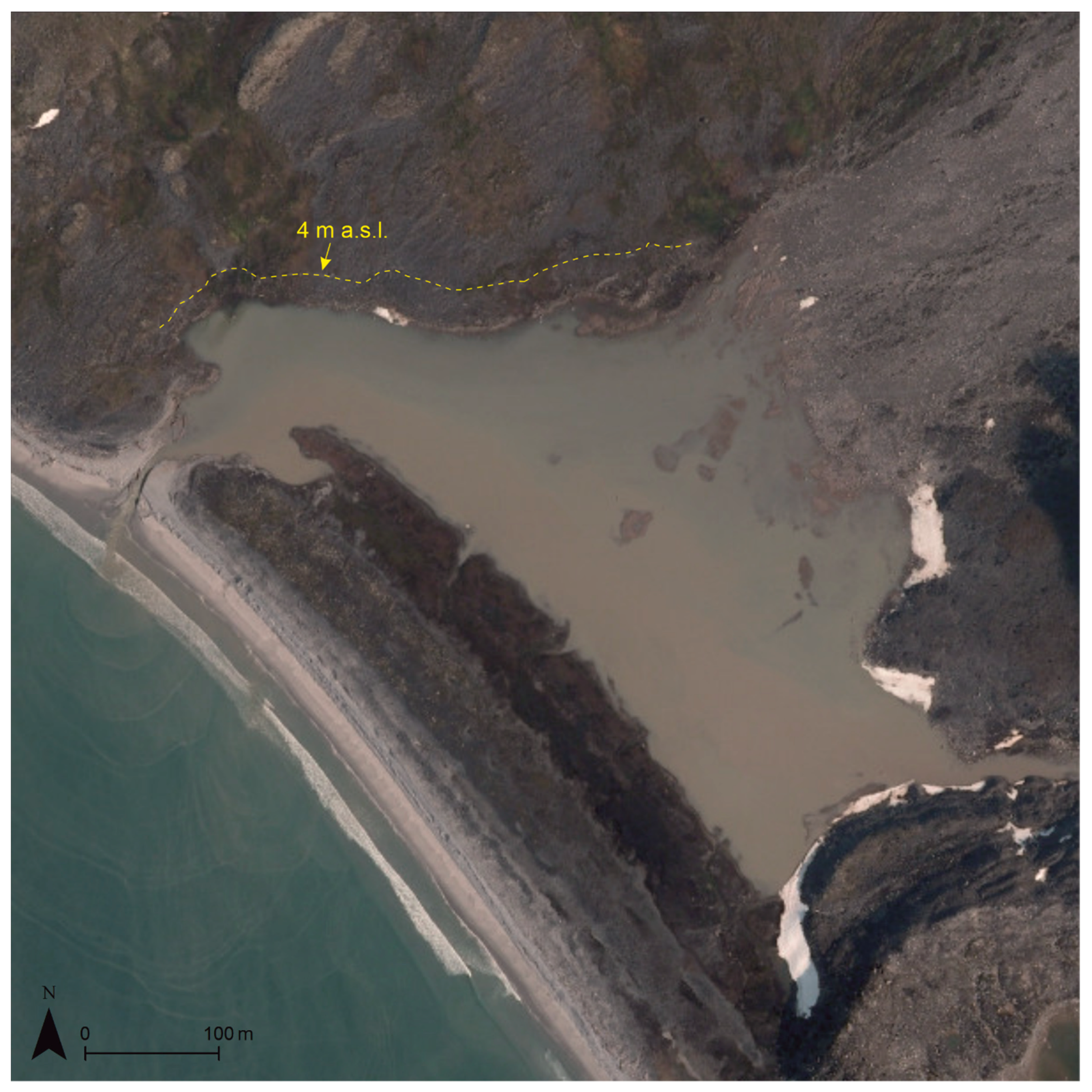
References
- Rantanen, M.; Karpechko, A.Y.; Lipponen, A.; Nordling, K.; Hyvärinen, O.; Ruosteenoja, K.; Vihma, T.; Laaksonen, A. The Arctic Has Warmed Nearly Four Times Faster than the Globe since 1979. Commun. Earth Environ. 2022, 3, 168. [Google Scholar] [CrossRef]
- Overland, J.E.; Wang, M.; Walsh, J.E.; Stroeve, J.C. Future Arctic Climate Changes: Adaptation and Mitigation Time Scales. Earths Future 2014, 2, 68–74. [Google Scholar] [CrossRef]
- Biskaborn, B.K.; Smith, S.L.; Noetzli, J.; Matthes, H.; Vieira, G.; Streletskiy, D.A.; Schoeneich, P.; Romanovsky, V.E.; Lewkowicz, A.G.; Abramov, A.; et al. Permafrost Is Warming at a Global Scale. Nat. Commun. 2019, 10, 264. [Google Scholar] [CrossRef] [PubMed]
- Allaart, L.; Schomacker, A.; Håkansson, L.M.; Farnsworth, W.R.; Brynjólfsson, S.; Grumstad, A.; Kjellman, S.E. Geomorphology and Surficial Geology of the Femmilsjøen Area, Northern Spitsbergen. Geomorphology 2021, 382, 107693. [Google Scholar] [CrossRef]
- Osuch, M.; Wawrzyniak, T.; Nawrot, A. Diagnosis of the Hydrology of a Small Arctic Permafrost Catchment Using HBV Conceptual Rainfall-Runoff Model. Hydrol. Res. 2019, 50, 459–478. [Google Scholar] [CrossRef]
- Nielsen, D.M.; Pieper, P.; Barkhordarian, A.; Overduin, P.; Ilyina, T.; Brovkin, V.; Baehr, J.; Dobrynin, M. Increase in Arctic Coastal Erosion and Its Sensitivity to Warming in the Twenty-First Century. Nat. Clim. Chang. 2022, 12, 263–270. [Google Scholar] [CrossRef]
- Fritz, M.; Vonk, J.E.; Lantuit, H. Collapsing Arctic Coastlines. Nat. Clim. Chang. 2017, 7, 6–7. [Google Scholar] [CrossRef]
- Screen, J.A. Arctic Amplification Decreases Temperature Variance in Northern Mid- to High-Latitudes. Nat. Clim. Chang. 2014, 4, 577–582. [Google Scholar] [CrossRef]
- Moon, T.A.; Overeem, I.; Druckenmiller, M.; Holland, M.; Huntington, H.; Kling, G.; Lovecraft, A.L.; Miller, G.; Scambos, T.; Schädel, C.; et al. The Expanding Footprint of Rapid Arctic Change. Earths Future 2019, 7, 212–218. [Google Scholar] [CrossRef]
- Barnhart, K.R.; Overeem, I.; Anderson, R.S. The Effect of Changing Sea Ice on the Physical Vulnerability of Arctic Coasts. Cryosphere 2014, 8, 1777–1799. [Google Scholar] [CrossRef]
- Young, I.R.; Zieger, S.; Babanin, A.V. Global Trends in Wind Speedand Wave Height. Science (1979) 2011, 332, 448–451. [Google Scholar] [CrossRef]
- Lantuit, H.; Overduin, P.P.; Couture, N.; Wetterich, S.; Aré, F.; Atkinson, D.; Brown, J.; Cherkashov, G.; Drozdov, D.; Donald Forbes, L.; et al. The Arctic Coastal Dynamics Database: A New Classification Scheme and Statistics on Arctic Permafrost Coastlines. Estuaries Coasts 2012, 35, 383–400. [Google Scholar] [CrossRef]
- Overduin, P.P.; Strzelecki, M.C.; Grigoriev, M.N.; Couture, N.; Lantuit, H.; St-Hilaire-Gravel, D.; Günther, F.; Wetterich, S. Coastal Changes in the Arctic. Geol. Soc. Spec. Publ. 2014, 388, 103–129. [Google Scholar] [CrossRef]
- Irrgang, A.M.; Bendixen, M.; Farquharson, L.M.; Baranskaya, A.V.; Erikson, L.H.; Gibbs, A.E.; Ogorodov, S.A.; Overduin, P.P.; Lantuit, H.; Grigoriev, M.N.; et al. Drivers, Dynamics and Impacts of Changing Arctic Coasts. Nat. Rev. Earth Environ. 2022, 3, 39–54. [Google Scholar] [CrossRef]
- Kasprzak, M.; Strzelecki, M.C.; Traczyk, A.; Kondracka, M.; Lim, M.; Migała, K. On the Potential for a Bottom Active Layer below Coastal Permafrost: The Impact of Seawater on Permafrost Degradation Imaged by Electrical Resistivity Tomography (Hornsund, SW Spitsbergen). Geomorphology 2016, 293, 347–359. [Google Scholar] [CrossRef]
- Bendixen, M.; Lønsmann Iversen, L.; Anker Bjørk, A.; Elberling, B.; Westergaard-Nielsen, A.; Overeem, I.; Barnhart, K.R.; Abbas Khan, S.; Box, J.E.; Abermann, J.; et al. Delta Progradation in Greenland Driven by Increasing Glacial Mass Loss. Nature 2017, 550, 101–104. [Google Scholar] [CrossRef]
- Bourriquen, M.; Mercier, D.; Baltzer, A.; Fournier, J.; Costa, S.; Roussel, E. Paraglacial Coasts Responses to Glacier Retreat and Associated Shifts in River Floodplains over Decadal Timescales (1966–2016), Kongsfjorden, Svalbard. Land Degrad. Dev. 2018, 29, 4173–4185. [Google Scholar] [CrossRef]
- Strzelecki, M.C.; Long, A.J.; Lloyd, J.M. Post-Little Ice Age Development of a High Arctic Paraglacial Beach Complex. Permafr. Periglac. Process. 2017, 28, 4–17. [Google Scholar] [CrossRef]
- Strzelecki, M.C.; Jaskólski, M.W.; Strzelecki, M.C. Arctic Tsunamis Threaten Coastal Landscapes and Communities -Survey of Karrat Isfjord 2017 Tsunami Effects in Nuugaatsiaq, Western Greenland. Nat. Hazards Earth Syst. Sci. 2020, 20, 2521–2534. [Google Scholar] [CrossRef]
- Jarosz, K.; Zagórski, P.; Moskalik, M.; Lim, M.; Rodzik, J.; Mędrek, K. A New Paraglacial Typology of High Arctic Coastal Systems: Application to Recherchefjorden, Svalbard. Ann. Am. Assoc. Geogr. 2022, 112, 184–205. [Google Scholar] [CrossRef]
- Shugar, D.H.; Burr, A.; Haritashya, U.K.; Kargel, J.S.; Watson, C.S.; Kennedy, M.C.; Bevington, A.R.; Betts, R.A.; Harrison, S.; Strattman, K. Rapid Worldwide Growth of Glacial Lakes since 1990. Nat. Clim. Chang. 2020, 10, 939–945. [Google Scholar] [CrossRef]
- Wieczorek, I.; Strzelecki, M.C.; Stachnik, L.; Yde, J.C.; Małecki, J. Inventory and Classification of the Post Little Ice Age Glacial Lakes in Svalbard. Cryosphere Discuss. 2022, preprint. [Google Scholar] [CrossRef]
- Tomczyk, A.M.; Ewertowski, M.W.; Carrivick, J.L. Geomorphological Impacts of a Glacier Lake Outburst Flood in the High Arctic Zackenberg River, NE Greenland. J. Hydrol. 2020, 591, 125300. [Google Scholar] [CrossRef]
- Rick, B.; Mcgrath, D.; Armstrong, W.; Mccoy, S.W. Dam type and lake location characterize ice-marginal lake area change in Alaska and NW Canada between 1984 and 2019. Cryosphere 2022, 16, 297–314. [Google Scholar] [CrossRef]
- How, P.; Messerli, A.; Mätzler, E.; Santoro, M.; Wiesmann, A.; Caduff, R.; Langley, K.; Bojesen, M.H.; Paul, F.; Kääb, A.; et al. Greenland-Wide Inventory of Ice Marginal Lakes Using a Multi-Method Approach. Sci. Rep. 2021, 11, 4481. [Google Scholar] [CrossRef]
- Dudek, J.; Wieczorek, I.; Suwiński, M.K.; Strzelecki, M. Multidecadal Analysis of Paraglacial Landscape Changes in the Foreland of Gåsbreen—Sørkapp Land, Svalbard. Authorea 2022, preprints. [Google Scholar] [CrossRef]
- Speetjens, N.J.; Hugelius, G.; Gumbricht, T.; Lantuit, H.; Berghuijs, W.R.; Pika, P.A.; Poste, A.; Vonk, J.E. The Pan-Arctic Catchment Database (ARCADE). Earth Syst. Sci. Data Discuss. in review. 2022. [Google Scholar] [CrossRef]
- Elvevold, S.; Dallmann, W.; Blomeier, D. Geology of Svalbard; Allen Institute for AI: Seattle, WA, USA, 2007; ISBN 9788276662375. [Google Scholar]
- Dallmann, W.; Piepjohn, K.; McCann, A.; Sirotkin, A.; Ohta, Y.; Gjelsvik, T. Geological Map of Svalbard 1:100,000, Sheet A5G Magdalenefjorden; SUDOC: Pittsburgh, PA, USA, 2005. [Google Scholar]
- Norwegian Polar Institute. © Norwegian Polar Institute. Available online: https://www.npolar.no/ (accessed on 18 November 2022).
- Zagórski, P.; Jarosz, K.; Superson, J. Integrated Assessment of Shoreline Change along the Calypsostranda (Svalbard) from Remote Sensing, Field Survey and GIS. Mar. Geod. 2020, 43, 433–471. [Google Scholar] [CrossRef]
- Jawak, S.D.; Andersen, B.N.; Pohjola, V.; Godøy, Ø.; Hübner, C.; Jennings, I.; Ignatiuk, D.; Holmén, K.; Sivertsen, A.; Hann, R.; et al. Sios’s Earth Observation (Eo), Remote Sensing (Rs), and Operational Activities in Response to COVID-19. Remote Sens. 2021, 13, 712. [Google Scholar] [CrossRef]
- Kavan, J. Early Twentieth Century Evolution of Ferdinand Glacier, Svalbard, Based on Historic Photographs and Structure-from-Motion Technique. Geogr. Ann. Ser. A Phys. Geogr. 2020, 102, 57–67. [Google Scholar] [CrossRef]
- Geyman, E.C.; van Pelt, W.J.J.; Maloof, A.C.; Aas, H.F.; Kohler, J. Historical Glacier Change on Svalbard Predicts Doubling of Mass Loss by 2100. Nature 2022, 601, 374–379. [Google Scholar] [CrossRef] [PubMed]
- Himmelstoss, E.A.; Henderson, R.E.; Kratzmann, M.G.; Farris, A.S. Digital Shoreline Analysis System (DSAS) Version 5.1 User Guide; Open-File Report 2021-1091; USGS: Reston, VA, USA, 2021. [Google Scholar]
- Baig, M.R.I.; Ahmad, I.A.; Shahfahad; Tayyab, M.; Rahman, A. Analysis of Shoreline Changes in Vishakhapatnam Coastal Tract of Andhra Pradesh, India: An Application of Digital Shoreline Analysis System (DSAS). Ann. GIS 2020, 26, 361–376. [Google Scholar] [CrossRef]
- Abdul Maulud, K.N.; Selamat, S.N.; Mohd, F.A.; Md Noor, N.; Wan Mohd Jaafar, W.S.; Kamarudin, M.K.A.; Ariffin, E.H.; Adnan, N.A.; Ahmad, A. Assessment of Shoreline Changes for the Selangor Coast, Malaysia, Using the Digital Shoreline Analysis System Technique. Urban Sci. 2022, 6, 71. [Google Scholar] [CrossRef]
- Sheeja, P.S.; Ajay Gokul, A.J. Application of Digital Shoreline Analysis System in Coastal Erosion Assessment. Int. J. Eng. Sci. Comput. 2016, 6, 7876–7883. [Google Scholar] [CrossRef]
- Geyman, E.C.; van Pelt, W.J.J.; Maloof, A.C.; Aas, H.F.; Kohler, J. 1936/1938 DEM of Svalbard [Data Set]; Norwegian Polar Institute: Tromsø, Norway, 2021. [Google Scholar] [CrossRef]
- Bhatt, U.S.; Walker, D.A.; Raynolds, M.K.; Walsh, J.E.; Bieniek, P.A.; Cai, L.; Comiso, J.C.; Epstein, H.E.; Frost, G.V.; Gersten, R.; et al. Climate Drivers of Arctic Tundra Variability and Change Using an Indicators Framework. Environ. Res. Lett. 2021, 16, 055019. [Google Scholar] [CrossRef]
- Markham, B.L.; Barker, J.L. Spectral Characterization of the Landsat-4 MSS Sensors. Photogramm Eng Remote Sens. 1983, 49, 811–833. [Google Scholar]
- Johansen, B.; Tømmervik, H. The Relationship between Phytomass, NDVI and Vegetationcommunities on Svalbard. Int. J. Appl. Earth Obs. Geoinf. 2014, 27, 20–30. [Google Scholar] [CrossRef]
- USGS. Available online: https://Earthexplorer.Usgs.Gov/ (accessed on 18 November 2022).
- SentinelHub EOBrowser. Available online: https://www.sentinel-hub.com/explore/eobrowser/ (accessed on 18 November 2022).
- Li, J.; Meng, Y.; Li, Y.; Cui, Q.; Yang, X.; Tao, C.; Wang, Z.; Li, L.; Zhang, W. Accurate Water Extraction Using Remote Sensing Imagery Based on Normalized Difference Water Index and Unsupervised Deep Learning. J. Hydrol. 2022, 612, 128202. [Google Scholar] [CrossRef]
- Porter, C.; Howat, I.; Noh, M.-J.; Husby, E.; Khuvis, S.; Danish, E.; Tomko, K.; Gardiner, J.; Negrete, A.; Yadav, B.; et al. ArcticDEM – Strips, Version 4.1. Harvard Dataverse 2022, V1. [Google Scholar] [CrossRef]
- Mercier, D.; Laffly, D. Actual Paraglacial Progradation of the Coastal Zone in the Kongsfjorden Area, Western Spitsbergen (Svalbard). Geol. Soc. Spec. Publ. 2005, 242, 111–117. [Google Scholar] [CrossRef]
- Zagórski, P. Shoreline Dynamics of Calypsostranda (NW Wedel Jarlsberg Land, Svalbard)during the Last Century. Pol. Polar Res. 2011, 32, 67–99. [Google Scholar] [CrossRef]
- Kim, D.; Jo, J.; Nam, S.-I.; Choi, K. Morphodynamic Evolution of Paraglacial Spit Complexes on a Tide-Influenced Arctic Fjord Delta (Dicksonfjorden, Svalbard). Mar. Geol. 2022, 447, 106800. [Google Scholar] [CrossRef]
- Kavan, J. Post-Little Ice Age Development of Coast in the Locality of Kapp Napier, Central Spitsbergen, Svalbard Archipelago. Mar. Geod. 2020, 43, 234–247. [Google Scholar] [CrossRef]
- Zagórski, P. The Influence of Glaciers on Transformation of the Coast of NW Part of Wedel Jarlsberg Land (Spitsbergen) in Late Pleistocene and Holocene. Słupskie Pr. Geogr. 2007, 4, 157–169. [Google Scholar]
- Strzelecki, M.C.; Long, A.J.; Lloyd, J.M.; Małecki, J.; Zagórski, P.; Pawłowski, Ł.; Jaskólski, M. The Role of Rapid Glacier Retreat and Landscape Transformation in Controlling the Post-Little Ice Age Evolution of Paraglacial Coasts in Central Spitsbergen (Billefjorden, Svalbard). Land Degrad. Dev. 2018, 29, 1962–1978. [Google Scholar] [CrossRef]
- Kavan, J.; Wieczorek, I.; Tallentire, G.D.; Demidionov, M.; Uher, J.; Strzelecki, M.C. Estimating Suspended Sediment Fluxes from the Largest Glacial Lake in Svalbard to Fjord System Using Sentinel-2 Data: Trebrevatnet Case Study. Water 2022, 14, 1840. [Google Scholar] [CrossRef]
- Strzelecki, M.C.; Szczuciński, W.; Dominiczak, A.; Zagórski, P.; Dudek, J.; Knight, J. New Fjords, New Coasts, New Landscapes: The Geomorphology of Paraglacial Coasts Formed after Recent Glacier Retreat in Brepollen (Hornsund, Southern Svalbard). Earth Surf. Process. Landf. 2020, 45, 1325–1334. [Google Scholar] [CrossRef]
- Mitchell, S.; Boateng, I.; Couceiro, F. Influence of Flushing and Other Characteristics of Coastal Lagoons Using Data from Ghana. Ocean Coast. Manag. 2017, 143, 26–37. [Google Scholar] [CrossRef]
- Vermaire, J.C.; Pisaric, M.F.J.; Thienpont, J.R.; Courtney Mustaphi, C.J.; Kokelj, S.V.; Smol, J.P. Arctic Climate Warming and Sea Ice Declines Lead to Increased Storm Surge Activity. Geophys. Res. Lett. 2013, 40, 1386–1390. [Google Scholar] [CrossRef]
- Jones, B.M.; Arp, C.D.; Jorgenson, M.T.; Hinkel, K.M.; Schmutz, J.A.; Flint, P.L. Increase in the Rate and Uniformity of Coastline Erosion in Arctic Alaska. Geophys. Res. Lett. 2009, 36, L03503. [Google Scholar] [CrossRef]
- Carrasco, A.R.; Ferreira, O.; Roelvink, D. Coastal Lagoons and Rising Sea Level: A Review. Earth Sci. Rev. 2016, 154, 356–368. [Google Scholar] [CrossRef]
- Ziaja, W.; Maciejowski, W.; Ostafin, K. Coastal Landscape Dynamics in Ne Sørkapp Land (SE Spitsbergen), 1900-2005. Ambio 2009, 38, 201–208. [Google Scholar] [CrossRef] [PubMed]
- Carrivick, J.L.; Tweed, F.S. A Global Assessment of the Societal Impacts of Glacier Outburst Floods. Glob. Planet. Chang. 2016, 144, 1–16. [Google Scholar] [CrossRef]
- Ewertowski, M.W.; Tomczyk, A.M. Reactivation of Temporarily Stabilized Ice-Cored Moraines in Front of Polythermal Glaciers: Gravitational Mass Movements as the Most Important Geomorphological Agents for the Redistribution of Sediments (a Case Study from Ebbabreen and Ragnarbreen, Svalbard). Geomorphology 2020, 350, 106952. [Google Scholar] [CrossRef]
- Emmer, A.; Vilímek, V. New Method for Assessing the Susceptibility of Glacial Lakes to Outburst Floods in the Cordillera Blanca, Peru. Hydrol. Earth Syst. Sci. 2014, 18, 3461–3479. [Google Scholar] [CrossRef]
- Cook, S.J.; Quincey, D.J. Estimating the Volume of Alpine Glacial Lakes. Earth Surf. Dyn. 2015, 3, 559–575. [Google Scholar] [CrossRef]
- Watson, C.S.; Kargel, J.S.; Shugar, D.H.; Haritashya, U.K.; Schiassi, E.; Furfaro, R. Mass Loss From Calving in Himalayan Proglacial Lakes. Front. Earth Sci. 2020, 7, 342. [Google Scholar] [CrossRef]
- Rana, N.; Sharma, S.; Sundriyal, Y.; Kaushik, S.; Pradhan, S.; Tiwari, G.; Khan, F.; Sati, S.P.; Juyal, N. A Preliminary Assessment of the 7th February 2021 Flashflood in Lower Dhauli Ganga Valley, Central Himalaya, India. J. Earth Syst. Sci. 2021, 130, 78. [Google Scholar] [CrossRef]
- Khadka, N.; Zhang, G.; Thakuri, S. Glacial Lakes in the Nepal Himalaya: Inventory and Decadal Dynamics (1977–2017). Remote Sens. 2018, 10, 1913. [Google Scholar] [CrossRef]
- Huss, M.; Fischer, M. Sensitivity of Very Small Glaciers in the Swiss Alps to Future Climate Change. Front. Earth Sci. 2016, 4, 34. [Google Scholar] [CrossRef]
- Noël, B.; Jakobs, C.L.; van Pelt, W.J.J.; Lhermitte, S.; Wouters, B.; Kohler, J.; Hagen, J.O.; Luks, B.; Reijmer, C.H.; van de Berg, W.J.; et al. Low Elevation of Svalbard Glaciers Drives High Mass Loss Variability. Nat. Commun. 2020, 11, 4597. [Google Scholar] [CrossRef]
- Ballantyne, C.K. A General Model of Paraglacial Landscape Response. Holocene 2002, 12, 371–376. [Google Scholar] [CrossRef]
- Mémin, A.; Spada, G.; Boy, J.P.; Rogister, Y.; Hinderer, J. Decadal Geodetic Variations in Ny-Ålesund (Svalbard): Role of Past and Present Ice-Mass Changes. Geophys. J. Int. 2014, 198, 285–297. [Google Scholar] [CrossRef]
- Raynolds, M.K.; Walker, D.A.; Maier, H.A. NDVI Patterns and Phytomass Distribution in the Circumpolar Arctic. Remote Sens. Environ. 2006, 102, 271–281. [Google Scholar] [CrossRef]
- Walker, D.A.; Epstein, H.E.; Jia, G.J.; Balser, A.; Copass, C.; Edwards, E.J.; Gould, W.A.; Hollingsworth, J.; Knudson, J.; Maier, H.A.; et al. Phytomass, LAI, and NDVI in Northern Alaska: Relationships to Summer Warmth, Soil PH, Plant Functional Types, and Extrapolation to the Circumpolar Arctic. J. Geophys. Res. Atmos. 2003, 108, 8169. [Google Scholar] [CrossRef]
- Xu, L.; Myneni, R.B.; Chapin, F.S.; Callaghan, T.v.; Pinzon, J.E.; Tucker, C.J.; Zhu, Z.; Bi, J.; Ciais, P.; Tømmervik, H.; et al. Temperature and Vegetation Seasonality Diminishment over Northern Lands. Nat. Clim. Chang. 2013, 3, 581–586. [Google Scholar] [CrossRef]
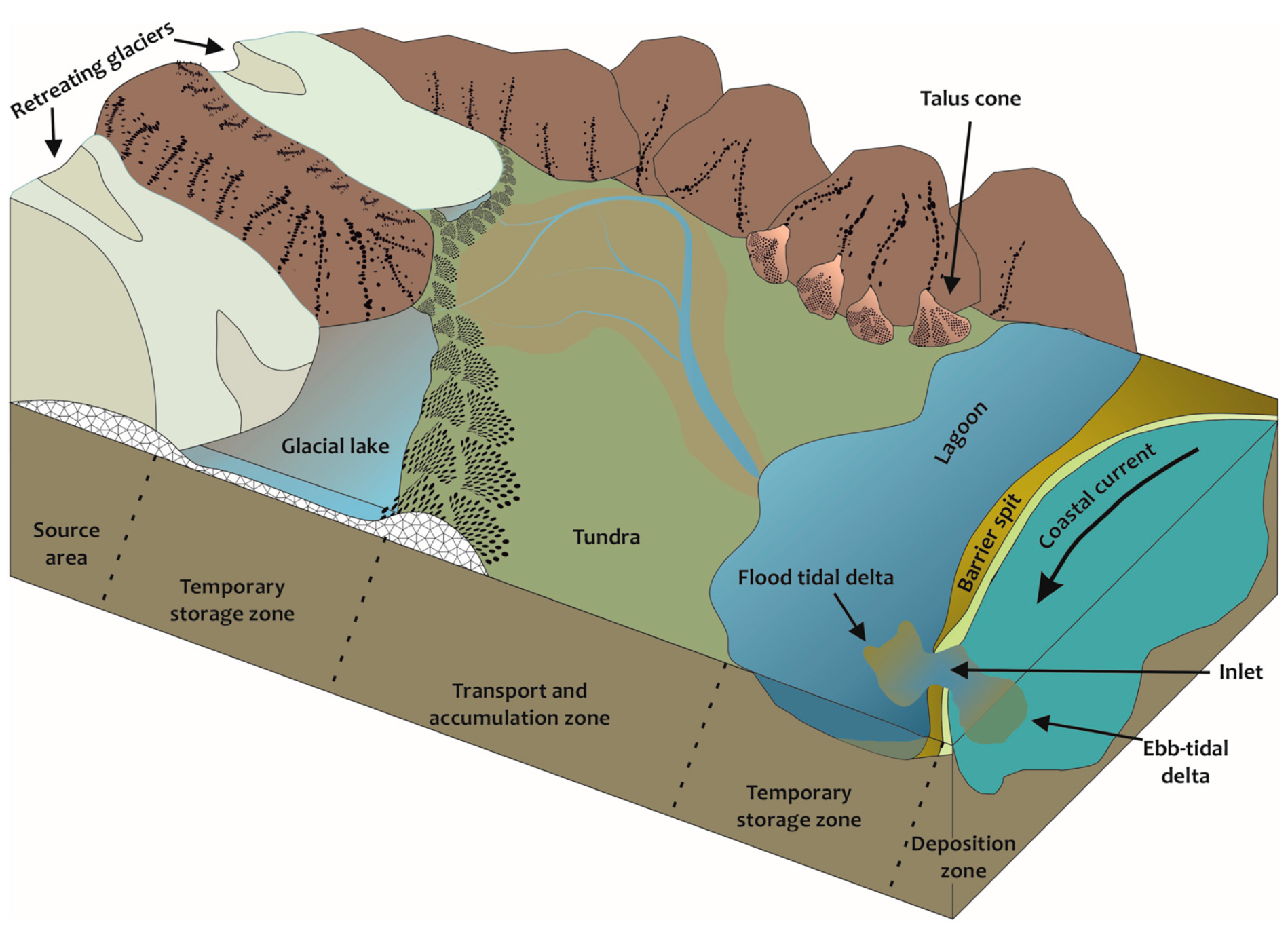

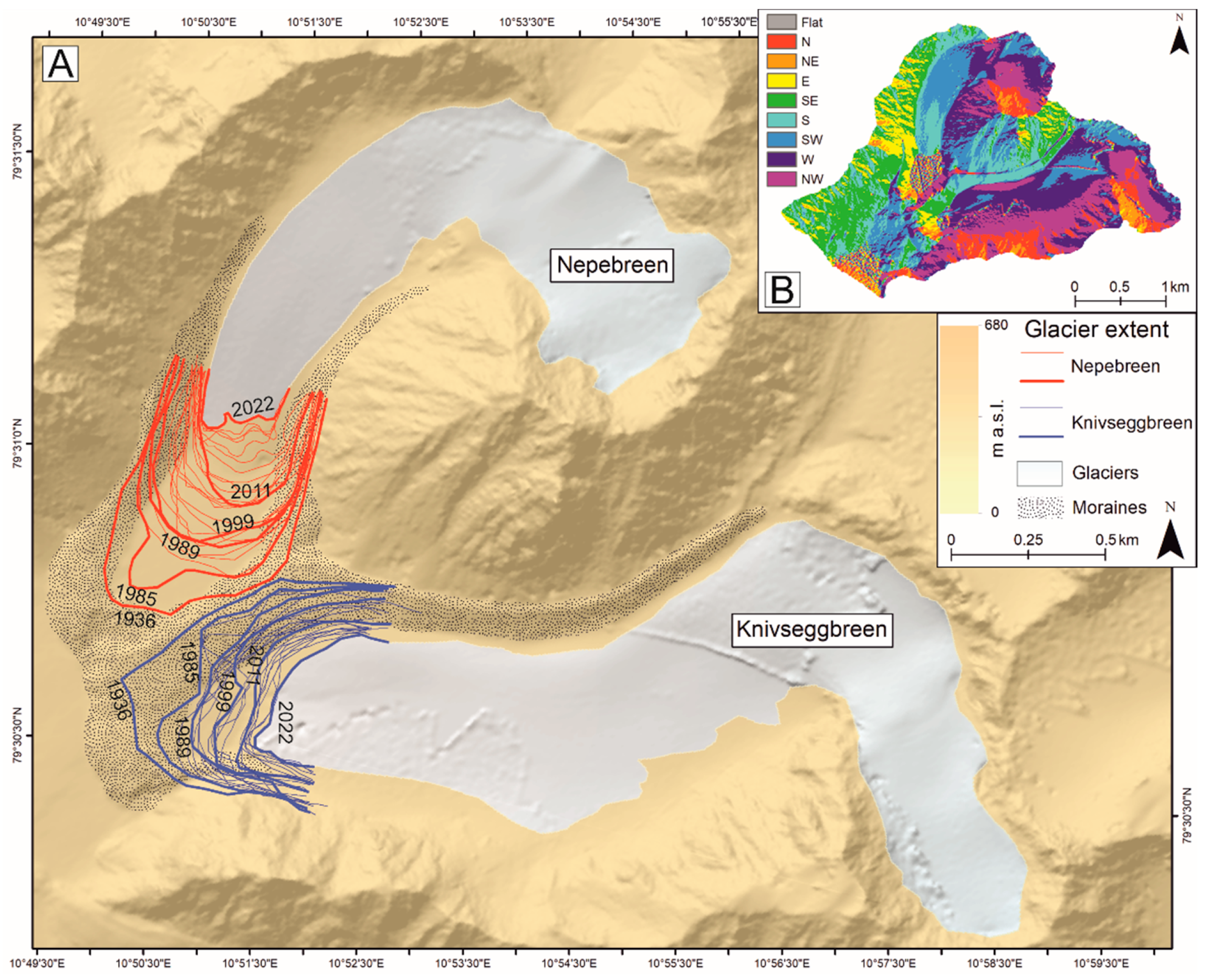
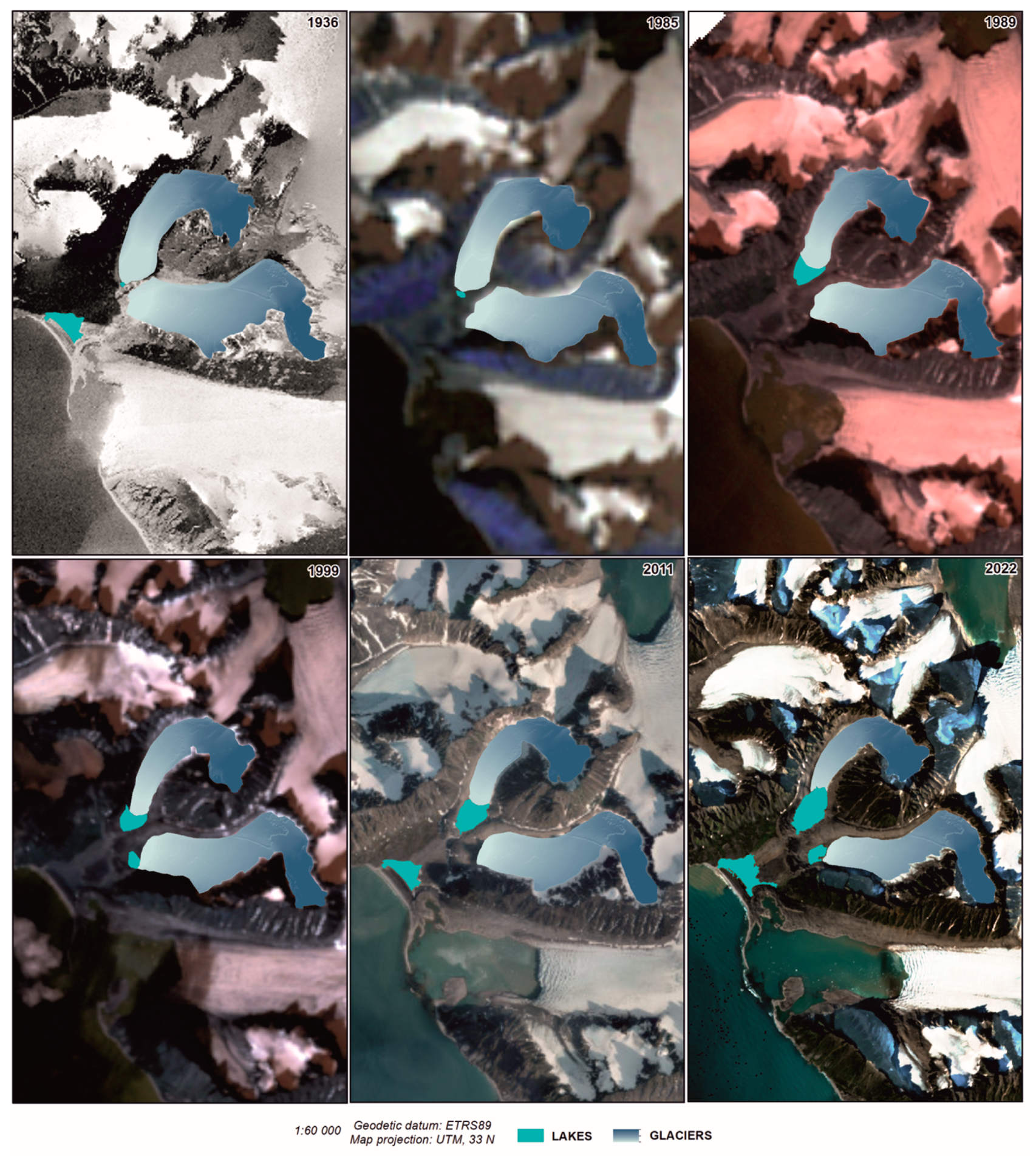
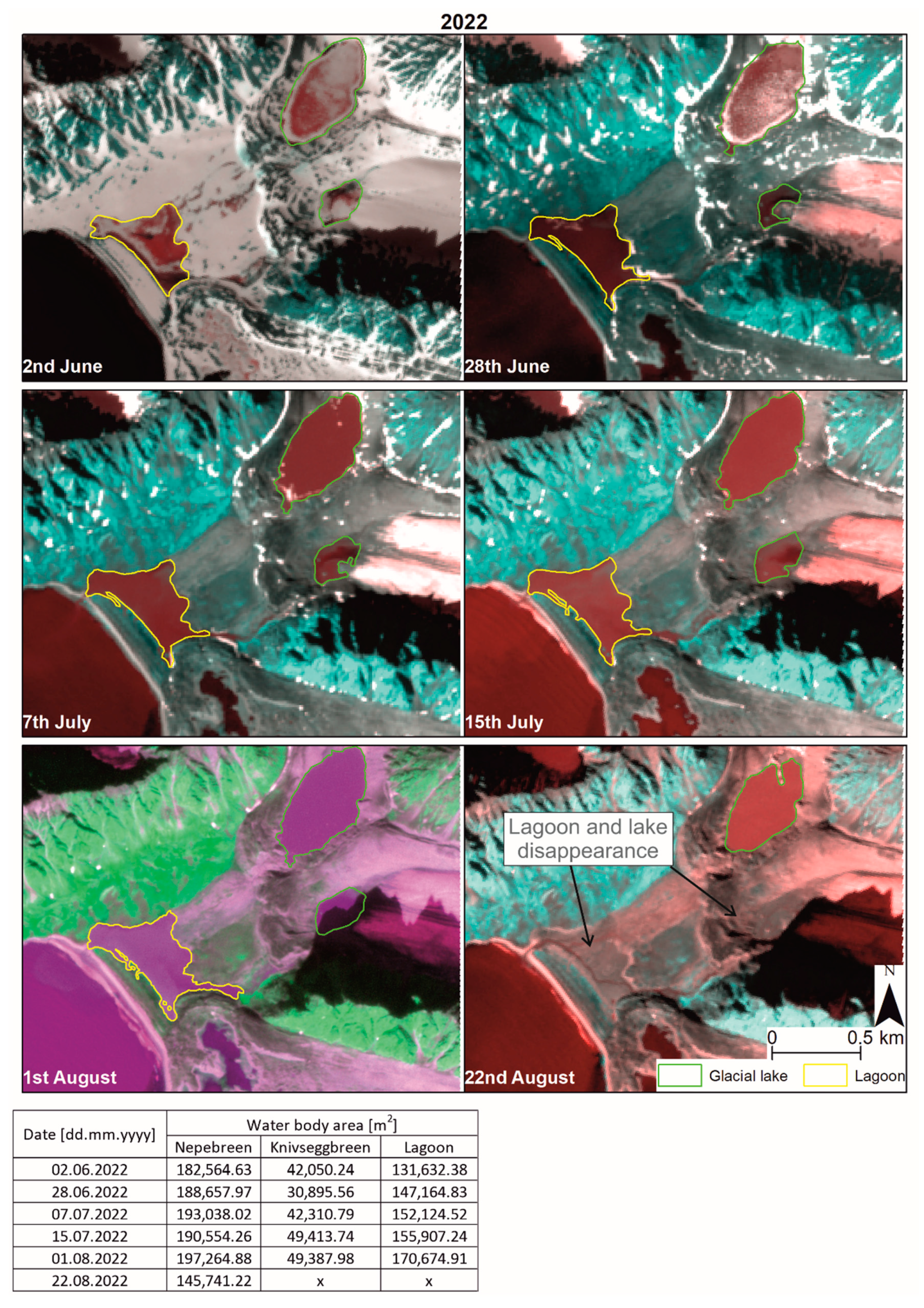


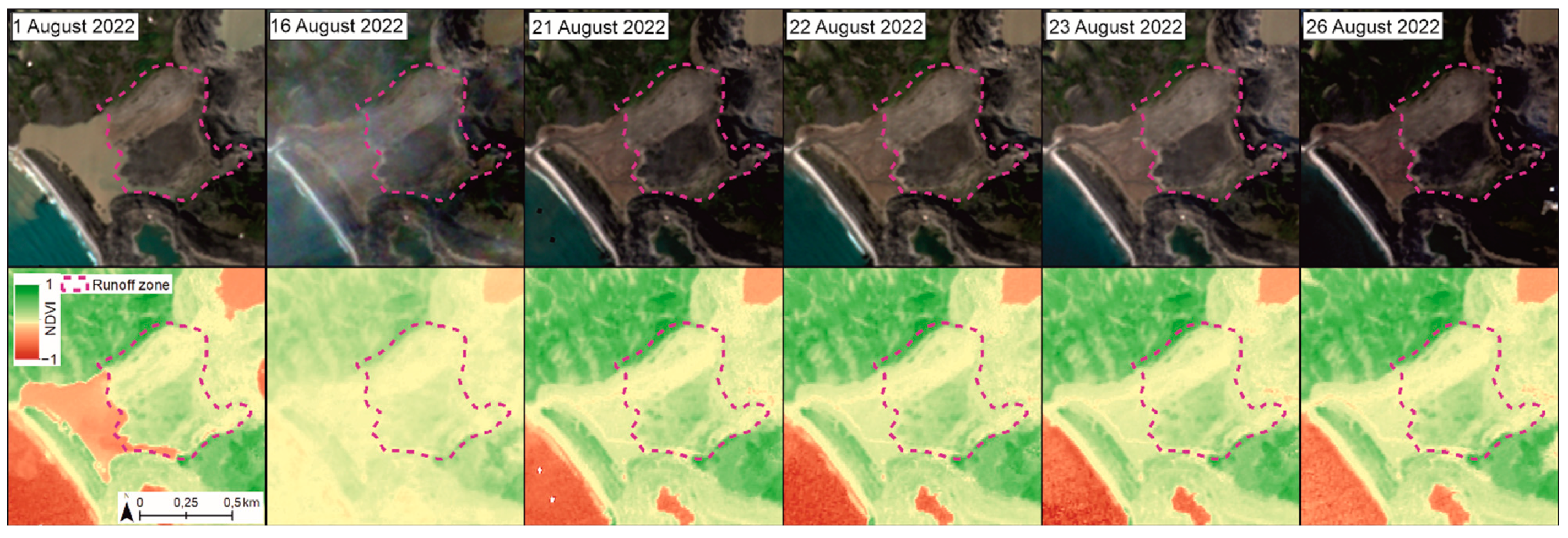
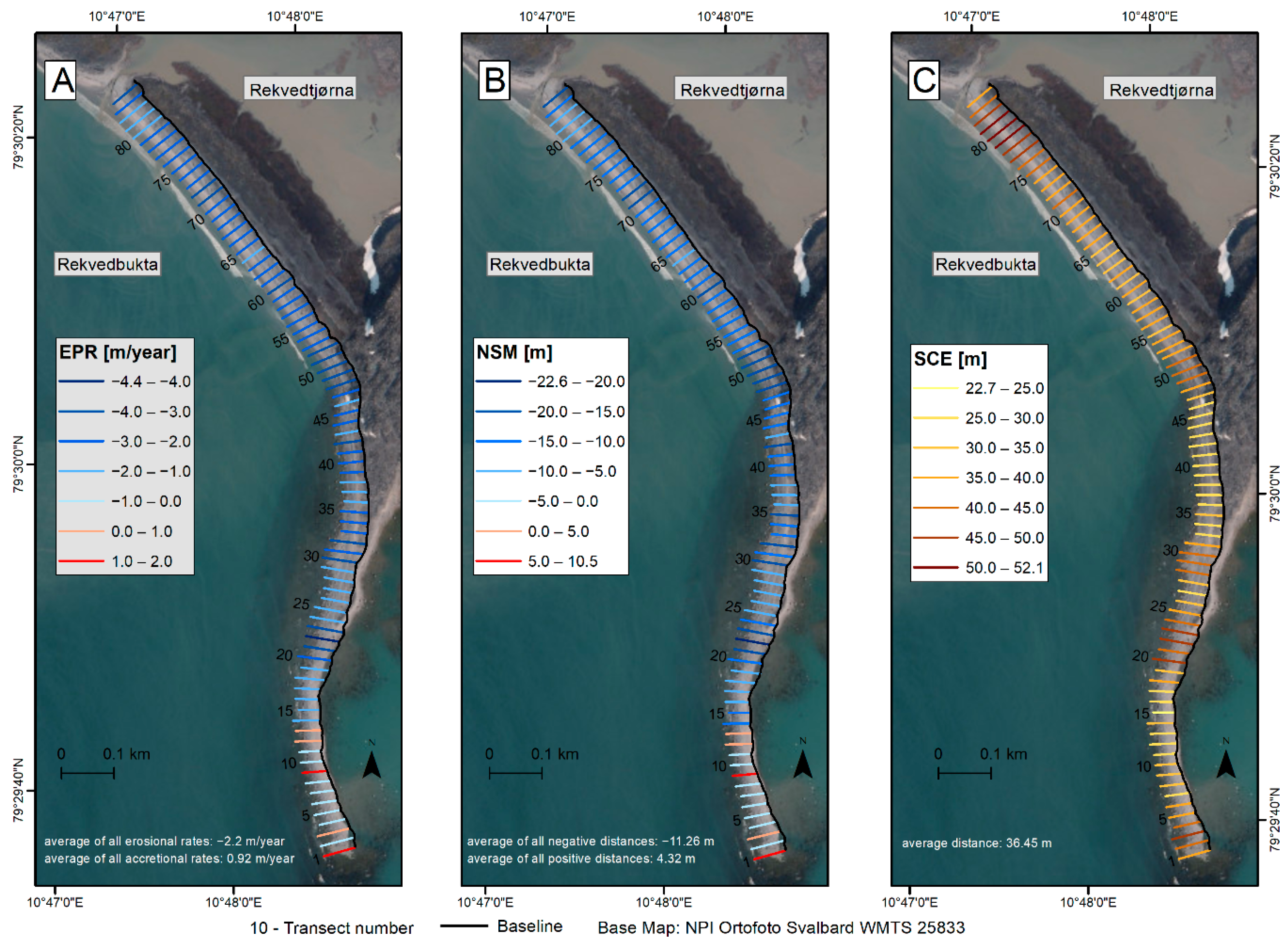
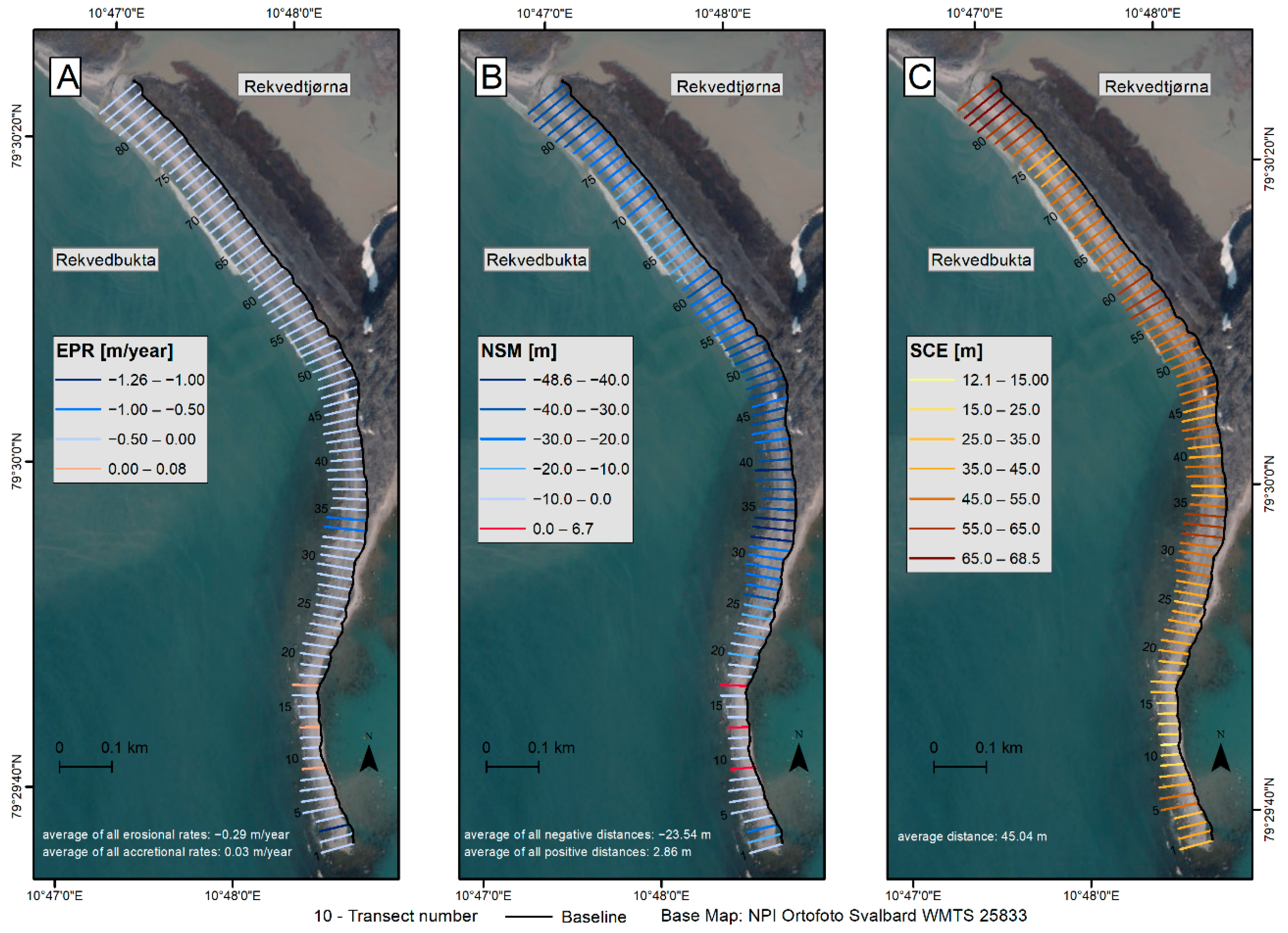
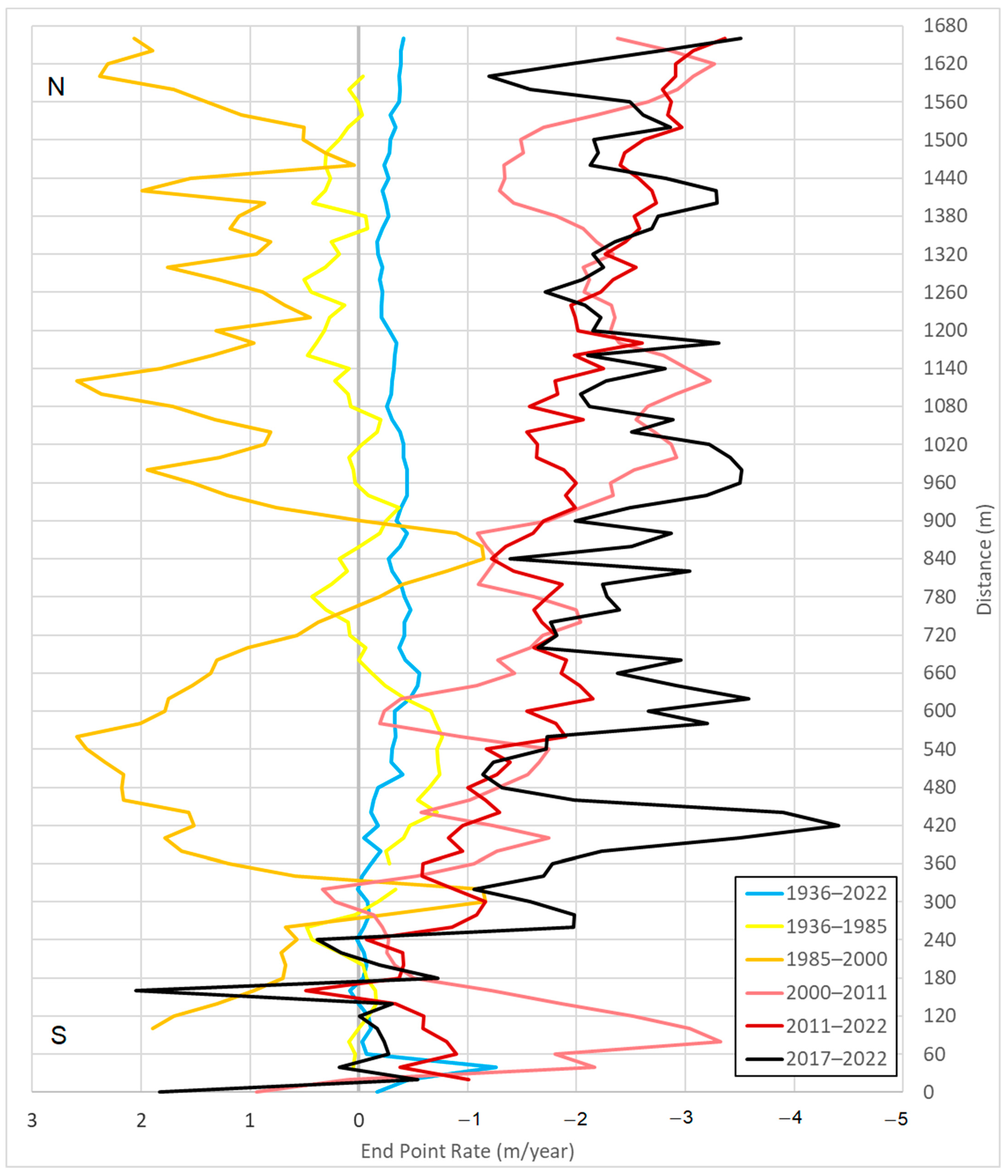

| Nepebreen—Aspect: SW | Knivseggbreen—Aspect: W | ||||
|---|---|---|---|---|---|
| Date | Mean Difference with Previous Glacier Extent [m] | Average Glacier Retreat Length [m] (Average Annual Velocity [m/y]) | Date | Mean Difference with Previous Glacier Extent [m] | Average Glacier Retreat Length [m] (Average Annual Velocity [m/y]) |
| 1936 | - | 391 (−4.55) | 1936 | - | 267 (−3.1) |
| 1985 | 70 | 1985 | 50 | ||
| 1989 | 83 | 1989 | 48 | ||
| 1999 | 24 | 1999 | 46 | ||
| 2011 | 107 | 2011 | 59 | ||
| 2022 | 112 | 2022 | 64 | ||
| Date | Resolution [m] | Satellite | Min Value | Max Value | Mean Value |
|---|---|---|---|---|---|
| 09 July 1976 | 60 × 60 | Landsat-2 | −0.80 | 0.16 | −0.17 |
| 22 August 1980 | 70 × 65 | Landsat-2 | −0.55 | 0.13 | −0.17 |
| 18 August 1990 | 35 × 35 | Landsat-5 | −0.35 | 0.47 | −0.06 |
| 25 August 2000 | 30 × 30 | Landsat-7 | −0.30 | 0.62 | 0.08 |
| 17 August 2011 | 30 × 30 | Landsat-7 | −0.30 | 0.50 | 0.06 |
| 28 August 2020 | 2 × 2 | Sentinel-2 | −1 | 1 | 0.12 |
Publisher’s Note: MDPI stays neutral with regard to jurisdictional claims in published maps and institutional affiliations. |
© 2022 by the authors. Licensee MDPI, Basel, Switzerland. This article is an open access article distributed under the terms and conditions of the Creative Commons Attribution (CC BY) license (https://creativecommons.org/licenses/by/4.0/).
Share and Cite
Wołoszyn, A.; Owczarek, Z.; Wieczorek, I.; Kasprzak, M.; Strzelecki, M.C. Glacial Outburst Floods Responsible for Major Environmental Shift in Arctic Coastal Catchment, Rekvedbukta, Albert I Land, Svalbard. Remote Sens. 2022, 14, 6325. https://doi.org/10.3390/rs14246325
Wołoszyn A, Owczarek Z, Wieczorek I, Kasprzak M, Strzelecki MC. Glacial Outburst Floods Responsible for Major Environmental Shift in Arctic Coastal Catchment, Rekvedbukta, Albert I Land, Svalbard. Remote Sensing. 2022; 14(24):6325. https://doi.org/10.3390/rs14246325
Chicago/Turabian StyleWołoszyn, Aleksandra, Zofia Owczarek, Iwo Wieczorek, Marek Kasprzak, and Mateusz C. Strzelecki. 2022. "Glacial Outburst Floods Responsible for Major Environmental Shift in Arctic Coastal Catchment, Rekvedbukta, Albert I Land, Svalbard" Remote Sensing 14, no. 24: 6325. https://doi.org/10.3390/rs14246325
APA StyleWołoszyn, A., Owczarek, Z., Wieczorek, I., Kasprzak, M., & Strzelecki, M. C. (2022). Glacial Outburst Floods Responsible for Major Environmental Shift in Arctic Coastal Catchment, Rekvedbukta, Albert I Land, Svalbard. Remote Sensing, 14(24), 6325. https://doi.org/10.3390/rs14246325






